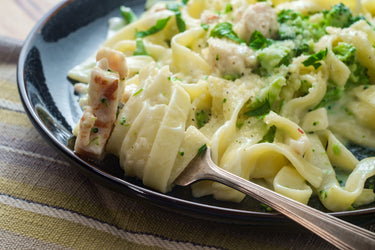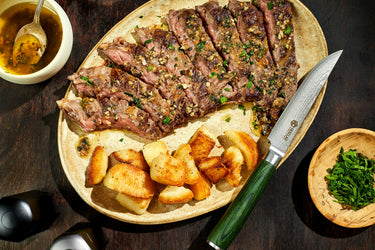10 Key Chemical Reactions in Cooking

Food is not only a craft and an art, but it’s also a science. While we may not have the periodic table running through our brain as we whisk an egg to fluffy perfection, cooking methods that make food taste so darn good are due to chemical reactions.
Knowing more about the key chemical reactions in cooking, and having the right tools to support them, can help you feel more comfortable experimenting in the kitchen. Replace those images of beakers and bunsen burners from chemistry class with those of your trusted stovetop and HexClad pans.
Today, we are learning all about the science of cooking.
What Are Some of the Most Common Chemical Reactions in the Kitchen?
When it comes to food science, there are 10 common chemical reactions that can aid you in crafting any dish you can dream up.
1. Fermentation
Humans have benefited from fermentation for as long as history has recorded. With a culinary history spanning over 8,000 years, we’ve been fermenting food long before we even knew what fermentation was.
Fermentation is the chemical process in which carbohydrate molecules break down without using oxygen — also known as anaerobically. Unlike many other food-based chemical reactions, fermentation does not require heat. Instead, living organisms are responsible for this age-old process.
These microorganisms allow us to experience the joys of beer, wine, yogurt, kombucha, sourdough bread, sauerkraut, and certain cheeses.
2. The Maillard Reaction
Biochemist Louis-Camille Maillard first discovered this complex chemical reaction in 1912. African American chemist John E Hodge popularized the method when he published a paper establishing the mechanisms for the Maillard reaction pathway in 1953.
Also known as a browning reaction, the Maillard reaction occurs when proteins react with reducing sugars via high heat. The result? The appealing golden-brown color we know and love. This process draws out rich, hidden flavors.
In a non-stick and heat-retaining pan such as the Hexclad skillet or wok, the Maillard reaction can also transform the chemical structure of the surface of the foods, adding delectable crisp and complex flavor notes.
3. Caramelization
Like the Maillard reaction, caramelization involves heating sugar molecules in low moisture, producing a golden-brown result. But, unlike the Maillard reaction, proteins are not included. Instead, caramelization is all about that sugar.
When sugar molecules such as glucose begin to break down at high heat, the chemical changes create darker colors, richer flavors, and alluring aromas that can sweeten up any meal. Any food with a high sugar content like onions, apples, zucchini, bananas, and even pure sugar itself can be caramelized.
4. Gluten Formation
Gluten occurs when two specific proteins, glutenin and gliadin, are mixed with water. These proteins are found in wheat and similar grains, and the process of gluten formation is the star of the show when it comes to making pasta, noodles, pizzas, and bread.
When baking bread, gluten can trap gas bubbles within the dough during fermentation, helping to raise the dough and bring about that classic bread texture that is chewy and airy all at once.
As you knead a dough, the water is dispersed throughout the flour content, allowing the proteins to bind and form thin, springy chains that help the dough hold its shape.
5. Pyrolysis
Pyrolysis is a thermal degradation process. It occurs when extremely high heat causes a substance to undergo thermal degradation without oxygen or other oxidants, breaking down into smaller and more volatile molecules. Thermal degradation changes the substance's chemical composition and can lead to caramelization or charring.
When it comes to pyrolysis, timing is key to avoid over-charing your foods as you cook. Having the right pan when working with a stovetop is also vital to help keep your food from burning. A HexClad hybrid skillet can help you achieve the perfect sear and crisp without losing any of your meal to the bottom of the pan, where they can stick and crisp beyond repair.
6. Acid-Base Reactions
Acids typically taste sour. ThinkL lemons, grapefruit, or pineapples. Some of the most common acidic foods used in cooking are tomatoes, vinegar, and lemons. Acids can help soften foods rich in proteins, such as tough or sinewy cuts of meat. A marinade containing tomatoes or lemon juice can tenderize the meat while also elevating the flavor.
On the other end of the scale are bases or alkalines, which are capable of neutralizing acids. There are two main bases that are cooking staples: eggs and baking powder.
These bases play a vital role in cooking, as they can react with acids to form gas bubbles that serve as leavening agents in dough. Eggs and baking soda are important ingredients in baked goods, as they balance out the sour taste of acids and create the ideal consistency.
7. Protein Denaturation
During protein denaturation, the weaker chemical bonds of protein molecules break down, transforming the once complex molecular structure of protein into a single long strand of amino acids.
Common forms of protein denaturation take place when protein-rich egg whites are heated or mixed with an acidic substance.
Depending on your method, protein denaturation can cause the protein to foam, add thickness as it binds ingredients in a batter, or lead to better browning due to the amino acids binding with carbohydrates.
8. Emulsification
Emulsifiers work by containing one part that is drawn to water and another that is drawn to oil. Then, the emulsifier can capture the oil droplets and disperses them throughout the water, holding them in place and stabilizing the mixture.
Egg yolks and butter contain powerful emulsifying proteins capable of holding together bearnaise sauce and aioli, while honey or mustard can work as flavorful emulsifiers in a homemade salad dressing.
9. Carbonization
Carbonization is a chemical reaction that occurs when complex carbon-based substances exposed to heat break down into elemental carbon and chemical compounds. This is a process that will come in handy when it comes to caring for your cast-iron or hybrid cookware.
So, carbonization can reduce the risk of foods getting stuck on the pan, as this is a main part of the seasoning process. When we season our cast irons, we need to apply a thin coat of unsaturated oil applied to the pan and heat it past the oil’s smoking point. This carbonizes the oil, making it harder to remove.
As the carbonized oil builds within your pan, it will add flavor to your dishes and form a barrier to keep food molecules from binding with the iron, forming that beloved non-stick surface.
10. Combustion
This reaction occurs when a substance and an oxidant, such as oxygen, combine quickly at high temperatures. The chemical reaction caused by the fuel, oxidant, and heat transfers energy in the form of light and heat — creating flames or smoke.
In our kitchens, the combustion of methane is responsible for powering gas stoves, while flambé relies on alcohol as the fuel in a combustion reaction. Setting certain foods ablaze this way can add a rich caramelized flavor as the alcohol cooks off.
Become a Pro in the Kitchen With the Right Tools
At Hexclad, we design our cookware to work hand-in-hand (or pan-in-pan) with these key chemical reactions for a more enjoyable cooking experience and a delicious end result.
Whisk up a mean emulsifier in our sleek and lightweight mixing bowls, let protein denaturation and acid-base reactions create fluffy eggs and pancakes on our 12 inch griddle pan, and put Maillard browning into action with our patented hybrid technology to create the perfect sear — stick-free.
Ready to become a food chemist whiz in the kitchen with Hexclad? You can check out all of HexClad’s forward-thinking cookware at our online store today.
Sources:
'Fermentation': When Food Goes Bad But Stays Good | NPR
The Maillard Reaction Turns 100 | Chemical and Engineering News





